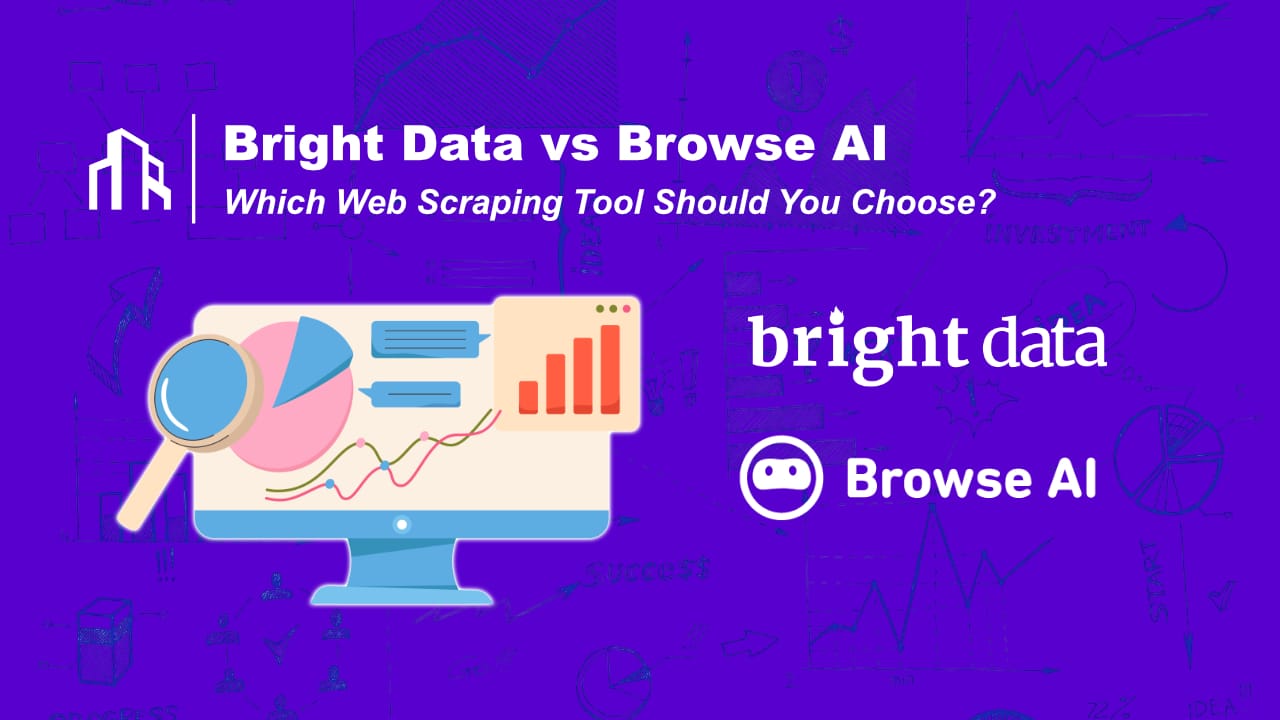Bright Data vs Browse AI: Which Web Scraping Tool Should You Choose?

Web scraping has become a cornerstone of modern business intelligence. From competitive pricing to market research and AI model training, the ability to access structured data at scale is more valuable than ever. Two of the most talked-about solutions today are Bright Data and Browse AI.
On the surface, both tools help you extract data from the web. But in reality, they serve very different audiences, operate with different pricing models, and are designed for different levels of technical expertise. This article takes a closer look at both platforms, comparing features, costs, strengths, and weaknesses and providing practical guidance on which tool is best suited for different needs.
Bright Data
Enterprise-grade web data platform with proxies, APIs, and datasets. Ideal for large-scale scraping, compliance-heavy industries, and teams that need reliable unblocking and data accuracy.
- ✓ Residential, ISP, mobile & datacenter proxies
- ✓ Web Unlocker & scraping APIs
- ✓ Enterprise compliance & SLAs

Browse AI
No-code web scraping and monitoring robots. Train robots visually to extract data, track competitors, and send results directly into Google Sheets, Airtable, or Zapier.
- ✓ Point & click robot training
- ✓ Scheduling & change monitoring
- ✓ Integrates with Sheets, Airtable, Zapier
Why Web Scraping Matters Today?
The way companies interact with the internet has shifted dramatically. Search engines increasingly provide AI-generated answers without clicks, marketplaces change prices hourly, and compliance requirements demand fresh monitoring of public data. In this environment, automation is not optional organizations need reliable pipelines of external data.
Two trends are driving this:
- Accessibility: Tools like Browse AI allow non-developers to set up robots in minutes, lowering the barrier to entry.
- Scalability: Enterprise platforms like Bright Data power high-volume data extraction across millions of pages, feeding data-hungry AI models and analytics systems.
Understanding the differences between these approaches is key to making a smart investment.
Bright Data: Built for Scale and Control
Bright Data positions itself as an enterprise-grade web data platform. It combines infrastructure, APIs, and pre-built datasets to enable data collection at virtually any scale.
Key features include:
- Proxy networks across residential, mobile, ISP, and datacenter IPs.
- Web Unlocker and Browser API to bypass CAPTCHAs and bot detection.
- Pre-collected datasets (e.g. e-commerce, social media, job postings).
- High compliance standards with audit logs and enterprise SLAs.
- Fine-grained control for developers via APIs and SDKs.
Bright Data is most often chosen by data-driven companies, research firms, and enterprises where reliability and scale matter more than simplicity.
Bright Data
Enterprise-grade web data platform with proxies, APIs, and datasets. Ideal for large-scale scraping, compliance-heavy industries, and teams that need reliable unblocking and data accuracy.
- ✓ Residential, ISP, mobile & datacenter proxies
- ✓ Web Unlocker & scraping APIs
- ✓ Enterprise compliance & SLAs
Browse AI: No-Code Robots for Quick Results
Browse AI takes a very different approach. Instead of dealing with proxies and APIs, you simply train a robot by pointing and clicking on a website. Within minutes, the robot can extract data, monitor changes, and feed results into Google Sheets, Airtable, or Zapier workflows.
Key features include:
- No-code setup through a browser extension.
- Robots that adapt to changing layouts.
- Monitoring and scheduling with alerts.
- Integrations with business tools for fast automation.
- Transparent credit-based pricing.
Browse AI shines for startups, SMBs, and non-technical teams that need reliable data quickly but don’t have in-house scraping expertise.

Browse AI
No-code web scraping and monitoring robots. Train robots visually to extract data, track competitors, and send results directly into Google Sheets, Airtable, or Zapier.
- ✓ Point & click robot training
- ✓ Scheduling & change monitoring
- ✓ Integrates with Sheets, Airtable, Zapier
Feature Comparison
| Capability | Bright Data | Browse AI |
|---|---|---|
| Proxy networks | Extensive (residential, mobile, ISP, datacenter) | Limited, less configurable |
| Handling anti-bot measures | Advanced unblocking APIs, CAPTCHA solving | Basic resilience, but weaker on protected sites |
| Ease of use | Technical setup required | No-code, easy onboarding |
| Scale | Billions of requests, enterprise infrastructure | Suitable for SMB and medium projects |
| Monitoring & scheduling | Enterprise dashboards and datasets | Strong for end-users, easy alerts |
| Integrations | APIs, SDKs, enterprise systems | Google Sheets, Airtable, Zapier |
| Compliance | Strong legal and enterprise compliance | Basic, sufficient for most SMBs |
Pricing: Two Very Different Models
Bright Data
Bright Data uses a usage-based model. Costs vary by data type and proxy:
- Residential proxies: $8/GB, dropping to ~$2.50/GB with high volume.
- Datacenter proxies: ~$0.90–$1.80/IP per month.
- Web Unlocker API: ~$1.50 per 1,000 requests.
- Pre-built datasets: from $250 for 100,000 records.
This flexibility is powerful for enterprises but can lead to unpredictable bills if usage spikes. For high-volume scraping, however, Bright Data becomes more cost-efficient than credit-based platforms.
Browse AI
Browse AI offers credit-based monthly plans:
- Free: 50 credits/month.
- Starter: $19/month.
- Professional: $69/month.
- Enterprise: from $500/month+.
Each action (like extracting a page) consumes credits. For low to moderate usage, Browse AI is cheaper and more predictable. But at scale, credits can add up quickly, making Bright Data more economical in the long run.
Use Cases in Practice
E-Commerce Price Monitoring
- Bright Data: Ideal for scraping thousands of product pages across multiple markets, even when protected by CAPTCHAs.
- Browse AI: Perfect for a small retailer tracking 20–50 competitors daily.
Lead Generation
- Bright Data: Best for pulling large B2B datasets from multiple sources.
- Browse AI: Good for capturing leads from specific directories or LinkedIn searches.
AI Model Training
- Bright Data: Provides massive, structured datasets suitable for training.
- Browse AI: Less suitable costs and limits make it inefficient at scale.
Compliance Monitoring
- Bright Data: Enterprise-ready with audit trails and data governance.
- Browse AI: Useful for monitoring a handful of sites for changes but lacks compliance depth.
Risks and Limitations
Bright Data
- Learning curve: Requires technical staff to configure properly.
- Variable costs: Bills can spike with unexpected usage.
- Overkill for small projects: Too heavy for simple monitoring tasks.
Browse AI
- Limited scalability: Credits become expensive at large volumes.
- Less reliable on protected sites: Robots may fail under heavy anti-scraping defenses.
- Data quality risk: Robots sometimes need re-training if sites change frequently.
Recommendations by Scenario
| Scenario | Best Choice |
|---|---|
| SMB tracking competitors, prices, or reviews | Browse AI |
| Enterprise scraping millions of records | Bright Data |
| AI model training requiring massive datasets | Bright Data |
| Marketing team needing quick dashboards | Browse AI |
| Compliance in regulated industries | Bright Data |
| Budget-sensitive startups | Browse AI |
Practical Tips Before Choosing
- Start with a pilot project. Use free trials to test how each tool handles your target websites.
- Calculate real demand. Estimate number of pages, frequency, and data size to project monthly cost.
- Don’t underestimate maintenance. Robots may break, proxies may need rotation, APIs may fail plan for it.
- Stay compliant. Scraping laws vary by region. Bright Data offers stronger compliance features for sensitive industries.
Final Verdict
There is no single “best” web scraping tool it depends on your context.
- Choose Browse AI if you need speed, simplicity, and predictable pricing for smaller projects. It’s ideal for marketers, SMBs, and non-technical users who want insights without coding.
- Choose Bright Data if you need scalability, reliability under anti-bot conditions, or enterprise-grade compliance. It’s the go-to solution for large organizations and data-driven enterprises.
In short: Browse AI is best for accessibility. Bright Data is best for scale.
Bright Data
Enterprise-grade web data platform with proxies, APIs, and datasets. Ideal for large-scale scraping, compliance-heavy industries, and teams that need reliable unblocking and data accuracy.
- ✓ Residential, ISP, mobile & datacenter proxies
- ✓ Web Unlocker & scraping APIs
- ✓ Enterprise compliance & SLAs

Browse AI
No-code web scraping and monitoring robots. Train robots visually to extract data, track competitors, and send results directly into Google Sheets, Airtable, or Zapier.
- ✓ Point & click robot training
- ✓ Scheduling & change monitoring
- ✓ Integrates with Sheets, Airtable, Zapier
Conclusion
The competition between Bright Data and Browse AI highlights a broader trend in the web scraping market: accessibility vs scalability. For many businesses, the smartest strategy is to start small with a no-code tool like Browse AI and then scale up to Bright Data once data needs become mission-critical.
Making the right choice isn’t just about cost, but about aligning your data strategy with your business model. With the right tool, you can turn the open web into a reliable stream of competitive advantage.
